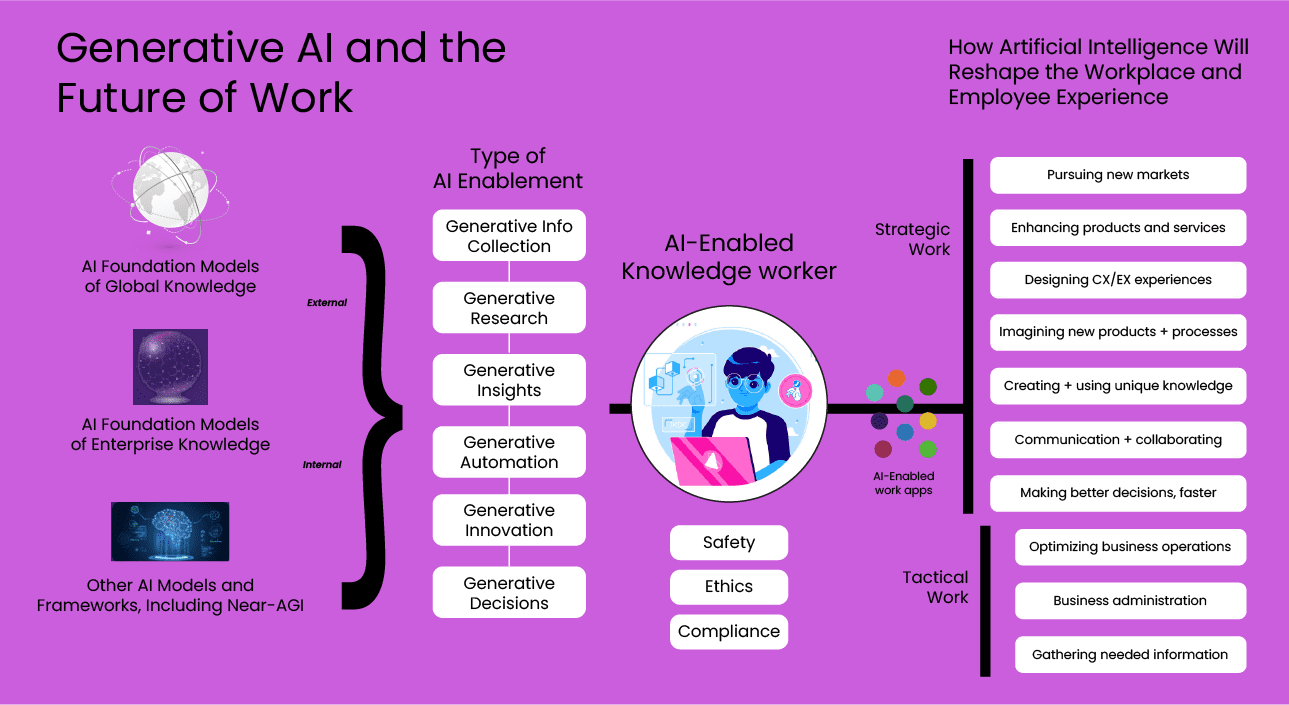- October 30, 2023
- Posted by: Kavitha V Amara
- Category: Data & Analytics

Generative AI catalyzes a profound shift in how companies innovate, operate, and conduct their work. The influence of generative AI, exemplified by ChatGPT, is poised to revolutionize revenue streams and bottom-line outcomes. Empowered by AI’s capacity to synthesize knowledge and swiftly translate it into tangible results, businesses can automate intricate tasks, expedite decision-making, generate invaluable insights, and unlock unparalleled potential at a once inconceivable scale.
Reinforcing this transformative potential, substantial research highlights the significant benefits of AI adoption. A recent extensive study projected that countries with widespread AI integration could experience a staggering 26% surge in their GDP by 2035. Furthermore, this same study anticipates a remarkable $15.7 trillion augmentation in global revenue and savings by 2030, all attributable to the profound impact of AI. Embracing generative AI technologies offers knowledge workers and business leaders a spectrum of new opportunities, propelling organizations to maintain competitiveness within the dynamic marketplace while achieving heightened efficiency, innovation, and growth.
While specific AI solutions are increasingly tailored to sectors such as financial services and healthcare, the most profound and widespread applications of AI manifest in general-purpose capabilities, significantly elevating the productivity and efficiency of professionals across industries, this horizontal domain has witnessed the surge of generative AI’s prominence over the last six months, as it garners attention for its immense potential in enhancing productivity, forging a new technological trajectory that leverages the collective knowledge of the world for individual tasks.
THE PROMISE OF GENERATIVE AI IN REDEFINING WORK
HARNESSING THE VALUE OF GENERATIVE AI AMIDST CHALLENGES
The ability of generative AI to effortlessly craft valuable, meticulously synthesized content like text and images from minimal prompts has evolved into an essential business capability, meriting provision to a vast array of knowledge workers. My research and investigation show that generative AI can accelerate work tasks by 1.3x to 5x, enhancing speed and efficiency. Additionally, there are intangible yet equally significant benefits in fostering innovation, embracing diverse perspectives, and managing opportunity costs. Generative AI’s prowess extends to producing high-value content such as code or formatted data, domains traditionally demanding specialized expertise and training. It can undertake sophisticated assessments of intricate, domain-specific materials, spanning legal documents to medical diagnoses.
In essence, contemporary generative AI services signify a tipping point, poised to deliver substantial value across various work scenarios, democratizing access to advanced capabilities for average workers.
However, prudence is imperative, as a chorus of cautionary voices underscores the underlying challenges. While AI is a potent force, it necessitates careful consideration to exploit its potential while mitigating its inherent risks, encompassing:
Addressing Data Bias: The effectiveness of generative AI models hinges on their training data, perpetuating biases if they’re present. This could inadvertently perpetuate unfavorable practices or exclude specific groups.
Enhancing Model Interpretability: The intricacies of generative AI models render their outcomes complex and challenging to decipher, potentially eroding trust in decision-making. This obscurity could be resolved as these models evolve.
Mitigating Cybersecurity Threats: Like any technology processing sensitive data, generative AI models are susceptible to cyber threats such as hacking, breaches, and input manipulation. Stringent measures are necessary to safeguard these systems and the associated data.
Navigating Legal and Ethical Considerations: Deploying generative AI in decision-making contexts such as hiring or lending necessitates alignment with legal and ethical standards. Ensuring compliance and safeguarding privacy is paramount.
Balancing AI Reliance: Overdependence on AI models can diminish human judgment and expertise. A balanced approach that values human input and AI’s enhancements is vital.
Sustaining Maintenance and Ethical Usage: Sustaining generative AI models demands ongoing upkeep, with businesses requiring the resources and infrastructure to manage and maintain them effectively. Addressing the energy consumption of these models is also imperative.
SEIZING THE POWER OF AI IN THE WORKPLACE
While challenges persist, the allure of AI’s benefits remains steadfast. As evidence accumulates, indicating the tangible outcomes of generative AI solutions, organizations must proactively institute operational, management, and governance frameworks that underpin responsible AI integration.
CRUCIAL STEPS IN DEPLOYING GENERATIVE AI AT WORK
Promulgating Clear AI Guidelines: Establish clear guidelines and policies for AI tool usage, emphasizing data privacy, security, and ethical considerations, fostering transparent use.
Empowering via Education and Training: Give employees thorough education and training to use AI tools effectively and morally while fostering a lifelong learning culture.
Structuring AI Governance: Implement robust governance frameworks for overseeing AI tool utilization, delineating responsibility, communication channels, and checks and balances.
Oversight and Vigilance: Ingrain mechanisms for continual oversight and monitoring of AI tools, ensuring compliance with guidelines, consistent model application, and unbiased outcomes.
Promoting Partnership and Feedback: Develop a collaborative workplace by fostering employee feedback and sharing best practices, resulting in a vibrant learning environment.
Enforcing Ethical Guidelines: Formulate ethical AI guidelines that prioritize transparency, fairness, and accountability, guiding the responsible use of AI tools.
Conducting Ethical Impact Assessments: Prioritize ethical impact assessments by deploying AI tools, addressing potential risks, and aligning means with moral principles.
Guarding Against Bias: Monitor AI tools for biases throughout development and deployment, ensuring fair and equitable outcomes.
Ensuring Transparency and Accordance: Furnish transparency about AI tool operations, decisions, and data usage, promoting understanding and trust.
Balancing Human and AI Expertise: Strike the proper equilibrium between AI augmentation and human expertise, preventing overreliance on AI’s capabilities.
These steps encompass a comprehensive approach to AI integration, capitalizing on AI’s power while mitigating its challenges. As organizations advance along the AI adoption curve, an encompassing ModelOps framework and the proper internal functions can be the bedrock for these practices.
FOUNDATION MODELS: THE KEYSTONE OF AI ENABLEMENT
To empower the workforce with AI-driven tools, organizations often turn to models that seamlessly generate valuable results without demanding significant user effort or training. Foundation models like Large Language Models (LLMs) are ideal candidates for powering AI work tools due to their extensive training in vast textual knowledge.
Vendors offering LLM-based work tools take distinct paths, either optimizing proprietary models or utilizing well-established models like OpenAI’s GPT-4. The prevailing foundation models encompass a diverse array of industry adoptions, including:
- AI21’s Jurassic-2
- Anthropic’s Claude
- Cohere’s Language Models
- Google’s Pathways Language Model (PaLM)
- Hugging Face’s BLOOM
- Meta’s LLaMA
- NVIDIA’s NeMo
- OpenAI’s GPT-3.5 and GPT-4
The selection of an appropriate model is integral to comprehending capabilities, safety measures, and potential risks, fostering informed decisions.
Dive deeper into AI integration strategies with our Text analytics leveraging teX.ai and LLM Success Story.
PIONEERING AI-ENABLED TOOLS FOR THE WORKFORCE
A gamut of AI-powered tools finds their basis in foundation models, synthesizing business content and insights. While many AI tools span various creative niches, the focus narrows to foundation model-powered, text-centric, and horizontally applicable tools, extending their utility to diverse professionals across industries. This list showcases AI tools that possess substantial potential for broader work contexts:
Bard – Google’s foray into the LLM-based knowledge assistant domain.
ChatGPT – The pioneer of general-purpose knowledge assistance, initiating the generative AI revolution.
ChatSpot – HubSpot’s content and research assistant, catering to marketing, sales, and operation’s needs.
Docugami – AI is bolstering business document management through specialized foundation models.
Einstein GPT – Salesforce’s content, insights, and interaction assistant, amplifying platform capabilities.
Google Workspace AI Features – Google’s integration of generative AI features into its productivity suite.
HyperWrite – A business writing assistant streamlining content creation.
Jasper for Business – An intelligent writing creator, ensuring brand consistency for external content.
Microsoft 365 Copilot/Business Chat – AI-assisted content generation and contextual user-data-driven business chatbots.
Notably – An AI-enhanced business research platform.
Notion AI – A business-ready content and writing assistant.
Olli – AI-powered enterprise-grade analytics and BI dashboards.
Poe by Quora – A knowledge assistant chatbot harnessing Anthropic’s AI models.
Rationale – An AI-powered tool aiding business decision-making.
Seenapse – AI-aided business ideation, propelling innovation.
Tome – An AI-driven tool for crafting PowerPoint presentations.
WordTune – A versatile writing assistant fostering content creation.
Writer – AI-based writing assistance, enhancing writing capabilities.
These tools encompass a broad spectrum of AI-enabled functionalities, focusing on text-based content and insights. While the landscape is evolving, with vertical AI solutions gaining traction, this list captures the essence of generative AI’s transformational impact on diverse facets of work.
In the journey toward the Future of Work, forthcoming explorations will delve into AI solutions tailored to specific industries, such as HR, healthcare, and finance. If you represent an AI-for-business startup utilizing foundation models and catering to enterprise clientele, I welcome you to connect. Engage for AI-in-the-workplace insights, advisory, and more.
Connect for AI advisory and explore AI’s potential in your business journey.
Wrapping Up
The potential of generative AI, exemplified by ChatGPT, is poised to revolutionize how we approach work in diverse industries. As research consistently highlights the significant benefits of AI adoption, it becomes clear that businesses embracing these technologies will enhance their efficiency and innovation and contribute to a global landscape of unprecedented progress. With the ability to automate intricate tasks and tap into a wealth of collective knowledge, generative AI opens up exciting new horizons for professionals and businesses, positioning them to thrive in an ever-evolving marketplace. This transformative wave promises economic growth and a future of work marked by creativity, efficiency, and boundless opportunity.





